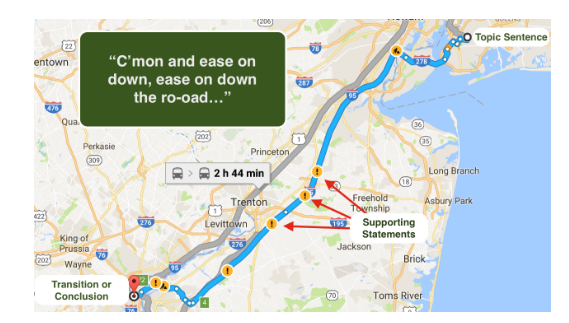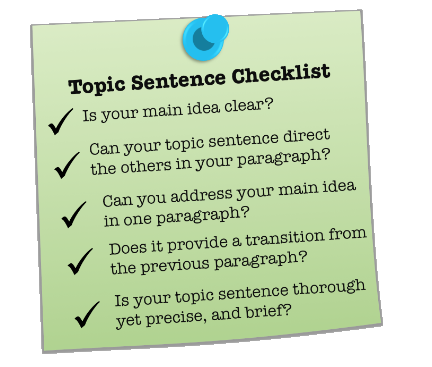Great essays can make you feel like you’re on a journey—while others are more like a bad road trip. What makes the difference? Often it’s as simple as the directions you’re given along the way.
To steer your readers through the curves and straightaways of your essay, it helps to give them signposts along the route. An important one is the topic sentence.
When woven throughout your argument, these important guides put your readers in the fast lane and help them arrive at your conclusion.
In this blog post, I’ll explain what a topic sentence is, teach you how to write one, and give a few examples of how it’s done.
What Is a Topic Sentence?
It’s simple enough. A topic sentence is the one sentence in a paragraph—usually the first—that informs readers of what’s to come.
Your topic sentence is like a mini-thesis statement. It provides important context and lets the reader anticipate what’s ahead. It introduces the main idea of a paragraph and supports the details that follow.
Before you set off on a journey, though, you need to know where you’re going and how to get there. The thesis statement is your map: it gives you a high-level view of where you’re going.

The topic sentence, then, is like a road sign along the way, revealing the next leg of the journey. It defines what’s immediately ahead.
And because each of your supporting paragraphs will support your main thesis—that specific claim or argument you’re hoping to make with your essay—your topic sentences will include both the topic of your paper and the main point you’re hoping to make about it to support that claim.
Your Topic Sentence = Your Topic + A Main Point
Got that? If not, it’s okay. Read on to see how it’s done.
Topic Sentence in Action: Where the Rubber Meets the Road
Let’s come up with a strong thesis statement for your hypothetical paper:
While some may find the prospect terrifying, the rise of self-driving cars will ultimately benefit society as they will reduce accidents, ease traffic congestion, and eliminate parking.
Here, we’re arguing that self-driving cars will ultimately reduce car accidents, lower time spent in traffic, and eliminate the need for parking.
But how do you turn these main points into topic sentences? Easily—with that equation above: Your Topic + A Main Point.
Let me show you how that looks in action with these three basic topic sentences:
- Self-driving cars will reduce accidents on the road.
- Self-driving cars will ease traffic congestion.
- Self-driving cars will eliminate the need for driving block by block at 3 a.m. looking for on-street parking while banging your head into the steering wheel.
The Nuts and Bolts of Topic Sentences
Now let’s take it further.
Your topic sentence has to go beyond simply stating what it is that you’ll be discussing. It’s not so much about the what as it is about the why. So let’s go back to that equation: Your Topic + A Main Point.
There are a few elements that make for a good topic sentence. Let’s cover each of these with examples.
Example 1: Make it thorough
A good topic sentence is thorough. It gives you enough content and context to provide a full discussion in the rest of the paragraph.
![]() The first true self-driving cars appeared in the 1980s.
The first true self-driving cars appeared in the 1980s.
This statement refers to your what—self-driving cars—so why isn’t it a good one?
Because it’s not thorough. It’s simply stating a fact. It doesn’t contain a real point of discussion on which you can elaborate in the rest of the paragraph.
Let’s try this topic sentence instead:
![]() Technological advancements in the 1980s ushered in the first true self-driving cars.
Technological advancements in the 1980s ushered in the first true self-driving cars.
This one includes that same fact—that self-driving cars appeared in the 1980s—but also a point of discussion—the technological advancements that drove that appearance. You can back this up with facts that elaborate how this came to be.
Example 2: Make it precise
A good topic sentence is precise. Avoid making vague or big statements that don’t clearly move your readers forward in their understanding of your discussion.
![]() I am going to explain how self-driving cars are better for the environment.
I am going to explain how self-driving cars are better for the environment.
Again, you’ve got that main topic—but this statement is a broad declaration. It lacks any precise point of discussion. The words “I am going to explain” also just add unnecessary filler to your sentence.
![]() While self-driving cars do not eliminate pollutants, their improved efficiency is a huge step toward a cleaner future.
While self-driving cars do not eliminate pollutants, their improved efficiency is a huge step toward a cleaner future.
This sentence gives you a lot to discuss.
(Need help with wordiness? Read Why Eliminating Wordiness Is So Important for Your Essay.)
Example 3: Make it brief
A good topic sentence is brief. Help your readers out by sticking to one main point. You’ll have the rest of your paragraph to add the details that expand, prove, or describe your topic.
![]() Self-driving cars should be a priority because they’re better than environment-polluting gas-guzzlers, and in just a few years, traffic will become so awful that no one will be able to get to where they need to.
Self-driving cars should be a priority because they’re better than environment-polluting gas-guzzlers, and in just a few years, traffic will become so awful that no one will be able to get to where they need to.
Pant, pant. This sentence is so convoluted. It’s difficult to know where to start. The main idea is not clear. Worse, there’s no one main point to support. And there’s too much to address in one paragraph.
Let’s try this topic sentence instead:
![]() Given how much self-driving cars could positively impact society, the automotive industry should make research and funding a priority.
Given how much self-driving cars could positively impact society, the automotive industry should make research and funding a priority.
By focusing on one main idea, your topic sentence can direct the supporting sentences within the paragraph.
Topic Sentence Checklist
Here are some quick questions to ask yourself about your topic sentences:
- Is your main idea clear?
- Can your topic sentence direct the other sentences in your paragraph?
- Can you address your main idea in one paragraph?
- Does it provide a transition from the previous paragraph?
- Is your topic sentence thorough yet precise, and brief?
If you answered yes, consider this your green light to proceed.
Next Stop: Check under the Hood
Now that you’ve populated each of your supporting paragraphs with a fleshed-out topic sentence, don’t forget to thoroughly review your essay for grammar mistakes, misspellings, and sentence structure errors.
If you need help, Kibin’s editors are familiar with essays of all makes and models. The last thing you want is to start your road trip only to find that you have a bad alternator.
Revved Up for More Help with Your Topic Sentences?

Get more help from Grammar Girl, who wrote a great blog post on the magic of a good topic sentence. To learn more about perfect paragraph structure in general, refer to this handout from the UNC-Chapel Hill Writing Center.
For help with your overall thesis statement, try Kibin’s easy Thesis Statement Builder. Learn better by example? See how other students have tackled their topic sentences in these example essays.
Pedal to the metal, writers!


